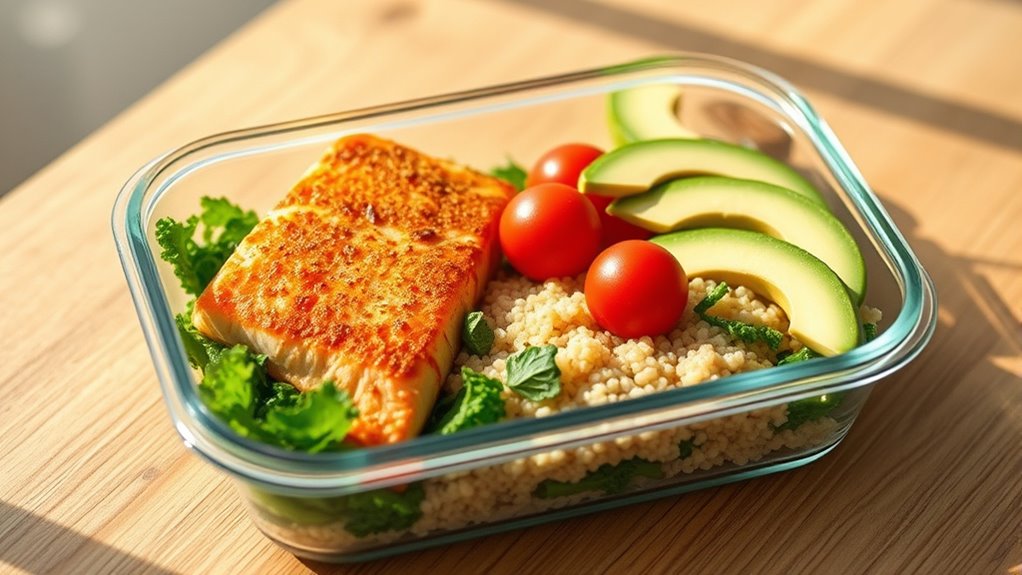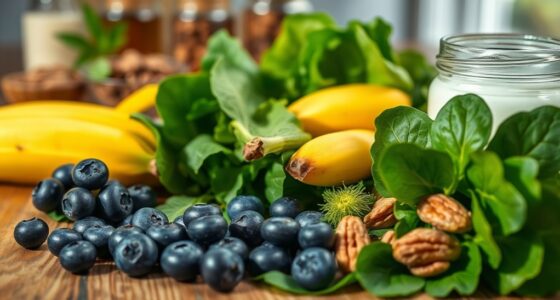To simplify anti-inflammatory meal prep for your busy lifestyle, focus on batch-cooking nutrient-rich dishes using herbs like turmeric, garlic, and ginger, which boost health and flavor. Mix spice blends to add variety without extra effort, and incorporate these into staples like roasted veggies, grains, and proteins. This approach saves time, controls ingredients, and keeps meals exciting. Keep exploring for tips on seasoning, combining herbs, and maintaining a nutritious, inflammation-reducing routine that fits your schedule.
Key Takeaways
- Plan and prepare nutrient-rich, anti-inflammatory meals in advance to save time and ensure consistent healthy eating.
- Incorporate herbs like turmeric, ginger, garlic, and rosemary to boost inflammation-fighting benefits easily.
- Use versatile spice blends such as cumin, cinnamon, and paprika to flavor meals and reduce reliance on salt or sugar.
- Marinate proteins and add spices to grains and vegetables during prep to enhance flavor and health benefits.
- Create a routine with layered, flavorful dishes to stay motivated and maintain inflammation-reducing habits long-term.

If you’re looking to reduce inflammation through your diet, meal prepping can be a game-changer. It allows you to control ingredients, ensure nutrient-rich meals, and avoid the temptation of less healthy options. One of the easiest ways to boost the anti-inflammatory properties of your meals is by focusing on herb combinations and spice blending. These natural flavor enhancers not only make your dishes more enjoyable but also pack a powerful health punch.
Start by choosing herbs like turmeric, ginger, garlic, and rosemary. These herbs are well-known for their anti-inflammatory benefits. When preparing your meals, experiment with herb combinations that complement each other, such as turmeric and black pepper or garlic and rosemary. Combining these herbs in your dishes can amplify their effects and make your meals more flavorful without added salt or sugar. Spice blending is another essential skill. Mix spices like cumin, cinnamon, paprika, and cayenne to create versatile blends that can be used across different meals. For example, a turmeric and cumin blend works beautifully in roasted vegetables or grain bowls, while cinnamon and paprika can enhance the flavor of roasted meats or stews.
As you plan your meal prep sessions, consider incorporating these spice blends into your recipes. Not only do they add depth to your dishes, but they also promote an anti-inflammatory response. Making your own spice blends gives you control over the ingredients, avoiding preservatives and fillers often found in store-bought mixes. Keep your blends in small jars, labeled clearly, so you’re ready to season your meals quickly during busy weekdays. This approach saves time and guarantees consistency in flavor and health benefits.
When prepping, focus on combining these herbs and spices into ingredients that store well, like roasted vegetables, grains, and lean proteins. For example, marinate chicken or tofu with a turmeric, garlic, and ginger paste before roasting. Mix your spice blends into lentil soups or grain salads to boost their health profile. By integrating herbs and spices into your meal prep routine, you turn simple dishes into powerful anti-inflammatory meals that are satisfying and easy to prepare ahead of time.
Additionally, utilizing sound design techniques such as layering and manipulation can help you create a more immersive and engaging meal prep experience, making healthy eating both enjoyable and satisfying. Finally, remember that consistent use of these herb combinations and spice blends can make a significant difference over time. They help you build a flavorful, nourishing diet without relying on supplements or processed foods. As a busy professional, this approach streamlines your meal prep, keeps your meals exciting, and supports your health goals—making inflammation reduction both achievable and delicious.
Frequently Asked Questions
Can Anti-Inflammatory Meals Improve Mental Clarity?
Yes, anti-inflammatory meals can improve your mental clarity by reducing brain fog and boosting cognitive function. When you choose foods rich in antioxidants, omega-3s, and vitamins, you support your brain’s health and decrease inflammation that hampers focus. By fueling your body with these nutrient-dense options, you’ll likely notice sharper thinking, better concentration, and enhanced mental energy throughout your busy day.
Are There Specific Snacks to Reduce Inflammation?
You might think snacking is just a quick fix, but the irony is, choosing the right snacks can actually fight inflammation. Healthy snacking with foods like nuts, berries, and dark chocolate helps reduce inflammation triggers. Instead of fueling the fire, these snacks soothe it. So, next time you reach for something, pick inflammation-fighting options—your body will thank you for the anti-inflammatory boost.
How Long Does It Take to See Benefits From Anti-Inflammatory Eating?
When you start anti-inflammatory eating, you might see changes in inflammation markers within a few weeks. Meal timing plays a role, as consistent, balanced meals help reduce inflammation faster. You may notice improved energy and less joint pain in as little as two to four weeks. Keep in mind, individual responses vary, but sticking to nutritious, anti-inflammatory foods regularly accelerates your progress toward better health.
Can Anti-Inflammatory Meal Prep Help With Chronic Pain Management?
You wonder if anti-inflammatory meal prep can help with chronic pain management. It can improve your meal prep efficiency, making it easier to stick with healthy choices. By consistently eating anti-inflammatory foods, you’ll likely see a reduction in inflammation markers over time, which may lessen pain symptoms. Staying dedicated to your meal plan helps manage inflammation and supports overall pain relief, making your daily routine more manageable.
Are There Any Anti-Inflammatory Foods to Avoid?
You should avoid foods that trigger inflammation, like processed sugars and fried foods, which can worsen your pain. Steer clear of sugary snacks, sodas, and baked goods high in refined sugars, as well as fried items like chips and fried chicken. Instead, focus on fresh fruits, vegetables, and healthy fats. By reducing these pro-inflammatory foods, you’re helping your body fight inflammation and support overall well-being.
Conclusion
By prepping anti-inflammatory meals, you can boost your energy and reduce stress even on hectic days. Imagine Sarah, a busy lawyer who starts each week with vibrant, nourishing dishes like turmeric chicken and quinoa salads. Within weeks, she notices increased focus and fewer afternoon crashes. You can experience the same benefits—just plan ahead, keep inflammation-fighting ingredients in mind, and enjoy healthier, more balanced days. Your busy schedule doesn’t have to mean sacrificing wellness.









